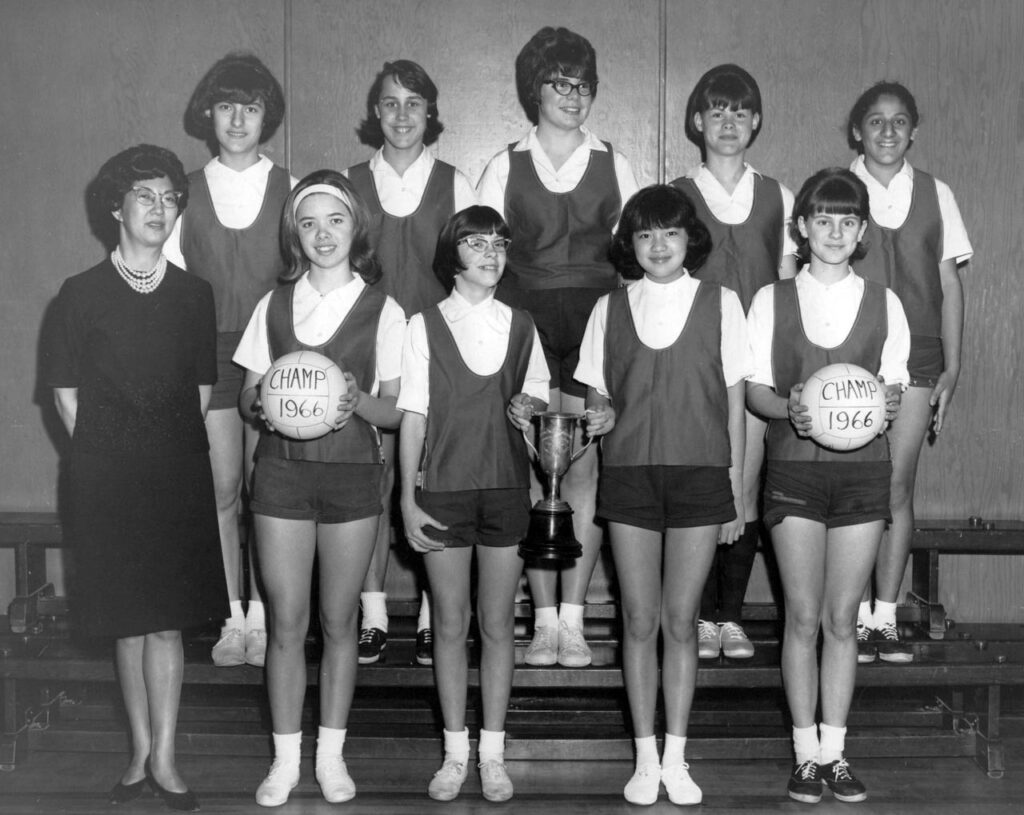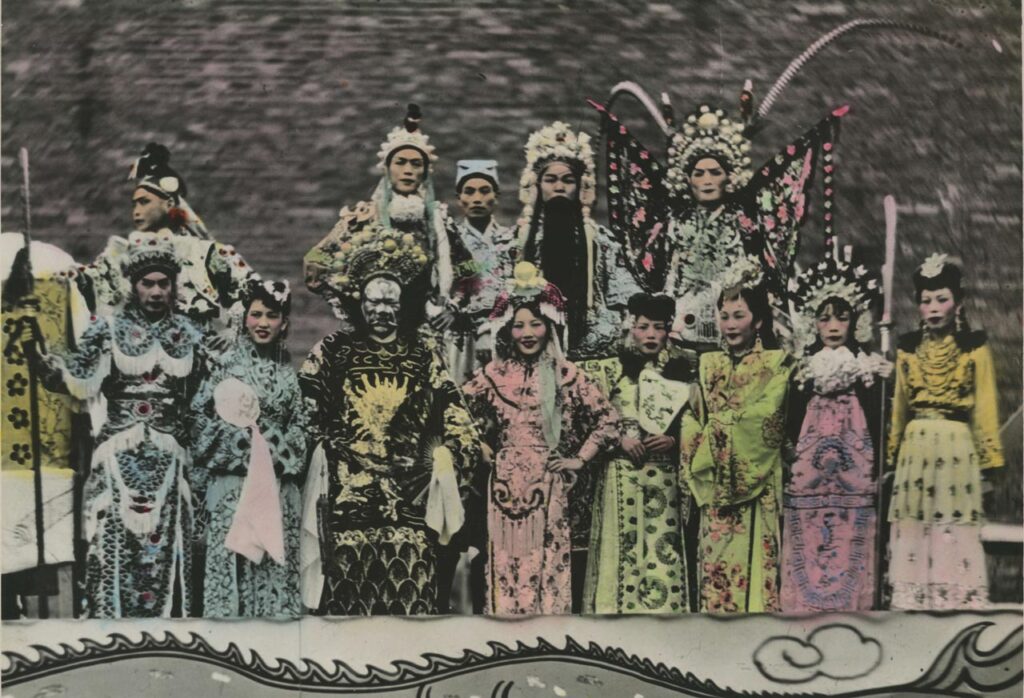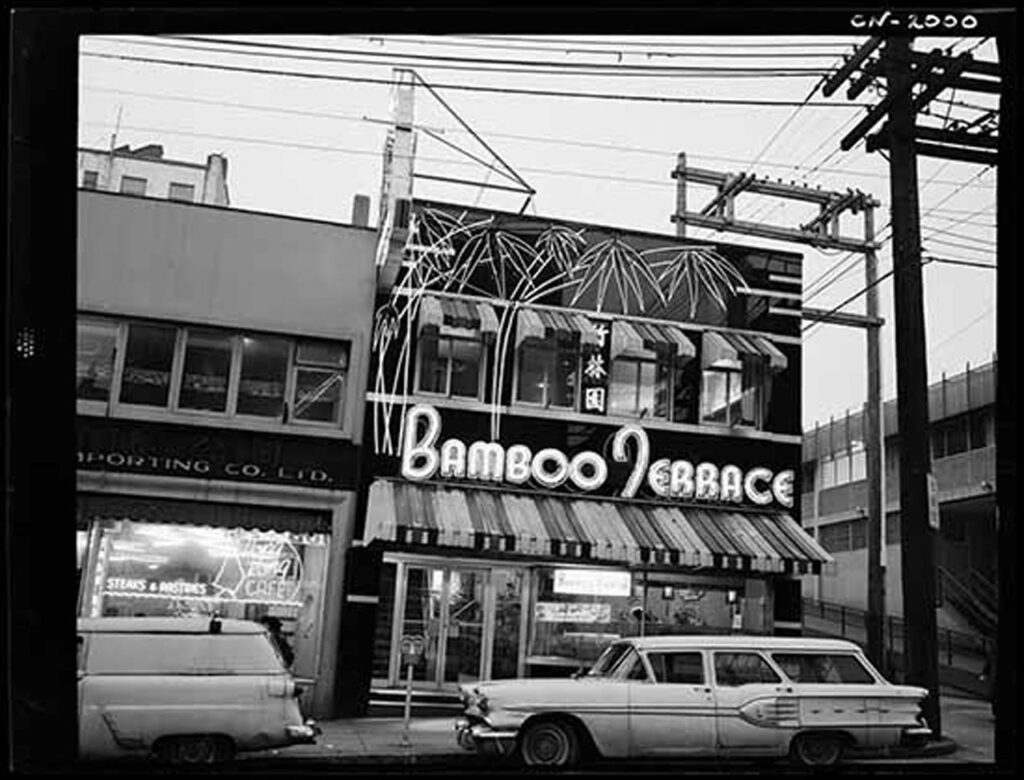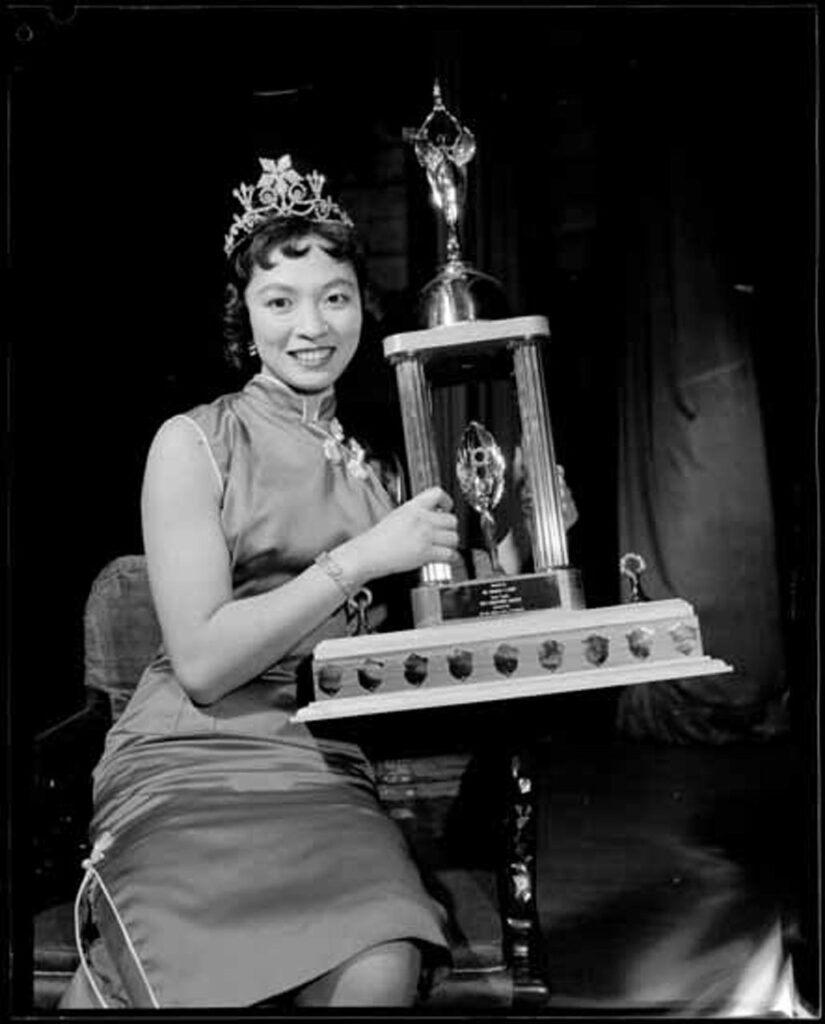Lesson #2: Commemorating Women’s Voices in Chinatown: Taking up Space

1945 Chinese women and children marching for VJ Day in Vancouver Chinatown, City of Vancouver Archives 1184-3047
Guiding Question
- How can we better understand what Chinatown was like for the women who lived there between the 1900s and 1970s?
Curricular Competencies
perspective and significance (both geographical and historical); evidence; continuity and change
Teacher-Led Lesson
This lesson focuses on Vancouver’s Chinatown but can be adapted for a local Chinatown or one in a nearby region (for example, Nanaimo or Cumberland).
Because this lesson asks students to explore why place matters to people and how we can develop a sense of place when exposed to multiple perspectives and experiences, it is important that the learning environment promotes intellectual curiosity, thoughtful engagement, and respectful appreciation of the perspectives of the people about the place in which they live, in this case, the Chinatown in Vancouver. Discussions may include colonial systems of oppression, misogyny in traditional Chinese culture, and institutional power. If you have not already explored Lesson #1 with your class, please consider taking the time to do so now.
If your group hasn’t yet examined the Suzhou Alley Women’s Mural, present the mural to the students at this time. Refer to the section “About the Suzhou Alley Women’s Mural” for some ideas of how to introduce the mural and its related topics to your students. You may also want to explore the supplementary resources to accompany your presentation (and lesson activities). Encourage students to freely explore the online reproduction of the mural and to discover some of the featured women using the mural key. If possible, consider arranging a field trip to visit the mural in person!
Engage students in a discussion of place and space (as individuals or in pairs):
- What is the difference between a place and a space?
- What makes them similar?
- How are they different?
Ask students:
- What are some important places within your school that students new to the school need to know?
- Why are these places important?
- After inviting students to share their responses with the class: Do we all agree on this list of places? Why or why not?
Explain that the mural is a type of commemoration. Offer or develop a definition of what a commemoration is.
For example: A commemoration or memorialization is a way to remember or honour and learn more about important people, developments, places, or events from the past.
There are many types of commemorations. They range from public holidays (Remembrance Day) to images on currency and stamps (Viola Desmond).
The SAWM is an example of public art and place-based commemoration. Other place-based commemorations tend to name important places after important people. These include the names of streets, parks, rivers, bridges, mountains, government and university buildings, schools, towns, and lakes.
When places are named after individuals, it shows that people at the time thought those individuals were important. It reveals the values of the people who chose to commemorate those individuals by using their names for particular places. It also shows how they value the place or what the place means to them (consider other factors, including intersectionality, people in power, and the social and political climate at the time).
For example: Immigrant advocate Lilian To had an alley named after her to honour her contributions and success in 2016 (“Mayor Gregor Robertson and SUCCESS to designate Lilian To Way today,” Canadian Immigrant) and a park in 2015 (“Lilian To Park at Yukon and W17th Avenue created from a street closure and single lot,” CityHallWatch). The alley is in Chinatown and the park is in the nearby neighbourhood of Mount Pleasant.
Provide an opportunity for preliminary discussion and speculation about what the people behind the mural value about Chinatown and who they determined to be important in the history of Chinatown.
Worksheet: Lesson #2 Neighbourhood Mapping
Using a map or a neighbourhood walkabout, gather names of local streets, buildings, and natural features like rivers and mountains. What do students recognize about who is being commemorated and where? Ask the class to consider what impression an outsider might have of your community by discovering who is commemorated and where within your community. Further, what inferences might they draw about members of the local community from their commemoration choices?
Explain that, over time, people’s ideas of who to memorialize and where have changed. Ask students how the SAWM could be considered a “different” commemoration in this respect, such as compared to commemorations from the 1950s or 1960s. Encourage them to go beyond the obvious and to discuss as deeply as possible how the mural highlights the influence of important women within the Chinatown and Vancouver communities. Ask students why this mural and its message are important for Chinatown and for the people who live and visit there.
Explain to students that developing a sense of a place isn’t as simple as learning about what it looks like on a map or how many millimetres of rain fall there. Learning about the people who live or lived there and what the place means or meant to them can help students come to a deeper understanding of the place and avoid stereotypes or generalizations about the place. For example, a stereotypical understanding of some locations in Northern Canada may include “isolated” or “barren.” Asking the following questions could help students better understand what it means to take on a geographical perspective and develop a more comprehensive understanding of a place:
- What is it like to live there?
- What does it mean to the people who live there?
- Why do the people who live there value this place?
- What does where you live mean to you?
* Worksheet: Lesson #2 Commemorations in Chinatown and Strathcona
Worksheet: Lesson #2 Commemorations in Chinatown and Strathcona
Project or share the following commemorations for Chinatown and Strathcona, a neighbouring community in Vancouver that overlaps with Chinatown, to compare and contrast with the SAWM. As a class, examine what and who the people behind the commemorations value and how they show a sense of place of Chinatown and Strathcona through the places and people they honour. Ask students how the commemorations best convey a sense of place. Ask them to reflect on what makes it easier for them to better understand the significance of Chinatown and the people who live and lived there. Discussion questions may include:
- Where do these commemorations “live”? For example, where are the plaques, historic sites, and places mentioned?
- Where exactly is the SAWM?
- Why does location matter?
- How do commemorations in a place influence a sense of place?
Chinatown and Strathcona commemorations:
- Black Strathcona (10 short videos)
- Vancouver’s Chinatown National Historic Site of Canada (4 pictures and 4 paragraphs)
- Vancouver Heritage Foundation, Places that Matter
Return the focus to the SAWM. Since the mural was created with the intention of being physically sited in Chinatown, discuss what influence or impact it may have within the community as well as for Vancouver at large. Discussion questions could include:
- How does the SAWM’s creation contribute to the historical narrative of Chinatown? Vancouver? Canada?
- How does its creation influence other narratives (personal narratives, community narratives)?
- What lens does it bring to the local community’s sense of place? How does the mural influence Vancouver’s Chinatown’s sense of place?
Wrap up your discussion by asking a central question that connects students’ learning to the other lessons:
- How would your sense of place in Chinatown be different without knowing about the SAWM, the important women featured, and their influence, impact, accomplishments, and contributions?
Culminating Activities
Five possible culminating activities include making a recommendation for the renaming of an important place in the local community; creating a collage to represent a sense of place; assessing the representation of place in the SAWM; choosing images that reflect students’ new understandings of Chinatown through the SAWM; and recognizing diversity within the lives of the women featured in the SAWM. These activities can be done individually, in pairs, or in small groups.
1) Collage a Place
Provide students with copies of archival images from Vancouver’s Chinatown or another community. Explain that students should choose a collection of images that showcase the diversity, uniqueness, sense of community, themes, and features that matter or resonate with people who live in that place. They should combine these images into a creative collage to represent a sense of place. This task is recommended for grades 5 and 9–12.
2) Rename a Place
Ask students to propose the renaming of either a local place to better reflect the values that resonate with current inhabitants of the community or a place in Vancouver’s Chinatown in honour of a woman featured in the SAWM. This could be in the form of a letter or email, podcast, video, or poster campaign. Students should include why people who live in the community may find the current name problematic and make a reasonable recommendation for a change. This task is recommended for grades 9–12.
3) Assess the Mural
Ask students to assess the richness of the SAWM artists’ representation of the sense of place for Vancouver’s Chinatown. When exploring a representation of a sense of place, certain types of information are more helpful than others. For example, when trying to get a sense of what a school is like, perhaps the square footage or number of students might not help to know what it’s like to be a student there. However, knowing what clubs it has or seeing images of common areas could help give an idea of what it means to have a sense of belonging there. Students should consider how the mural shows a unique history of Chinatown while simultaneously revealing what this community had in common with other places. They should also consider how it shows the different features of Chinatown important to its diverse members and how the mural reflects different themes that the community finds important. This task is recommended for grades 9–12.
*Worksheet: Lesson #2 Assess the Mural
4) An Expanded View of Chinatown
Ask students to choose three features in the mural or in photographs on the website that show an aspect of Chinatown that they weren’t expecting based on what they already knew about Chinatown. Ask them to discuss their choices and how this imagery helped them develop a better sense of place for Vancouver’s Chinatown. This task is equally recommended for grades 5 and 9–12.
Tracing Diversity
Ask students to explore the diversity of Chinese women in the history of Chinatown. Provide the students with archival materials from the website and the digital stories. Encourage them to recognize the differences in their experiences living in the same place and, in some cases, at the same time. Ask students to choose three important differences in the lives of a small group of women featured in the SAWM. This activity is intended for grades 9–12 and could be adapted for grade 5 by pre-selecting resources on a small group of women for discovery in groups or pairs.
*Worksheet: Lesson #2 Tracing Diversity
Assessment
If you choose to assess any of these culminating activities, you may prefer to use Social Studies proficiency scales that you are familiar with or you may apply some of the following assessment criteria:
- Showcase the diversity, uniqueness, sense of community, and themes and features that matter or resonate with people who live in a particular place.
- Identify why a commemoration may be problematic, reasonable, respectful, or resonate with the present community but also reflect the past community.
- Gather evidence for each criterion when exploring a representation of a sense of place.
- Explain what makes up a sense of place (characteristics and features).
- Distinguish important differences—looking for diversity within a community.









